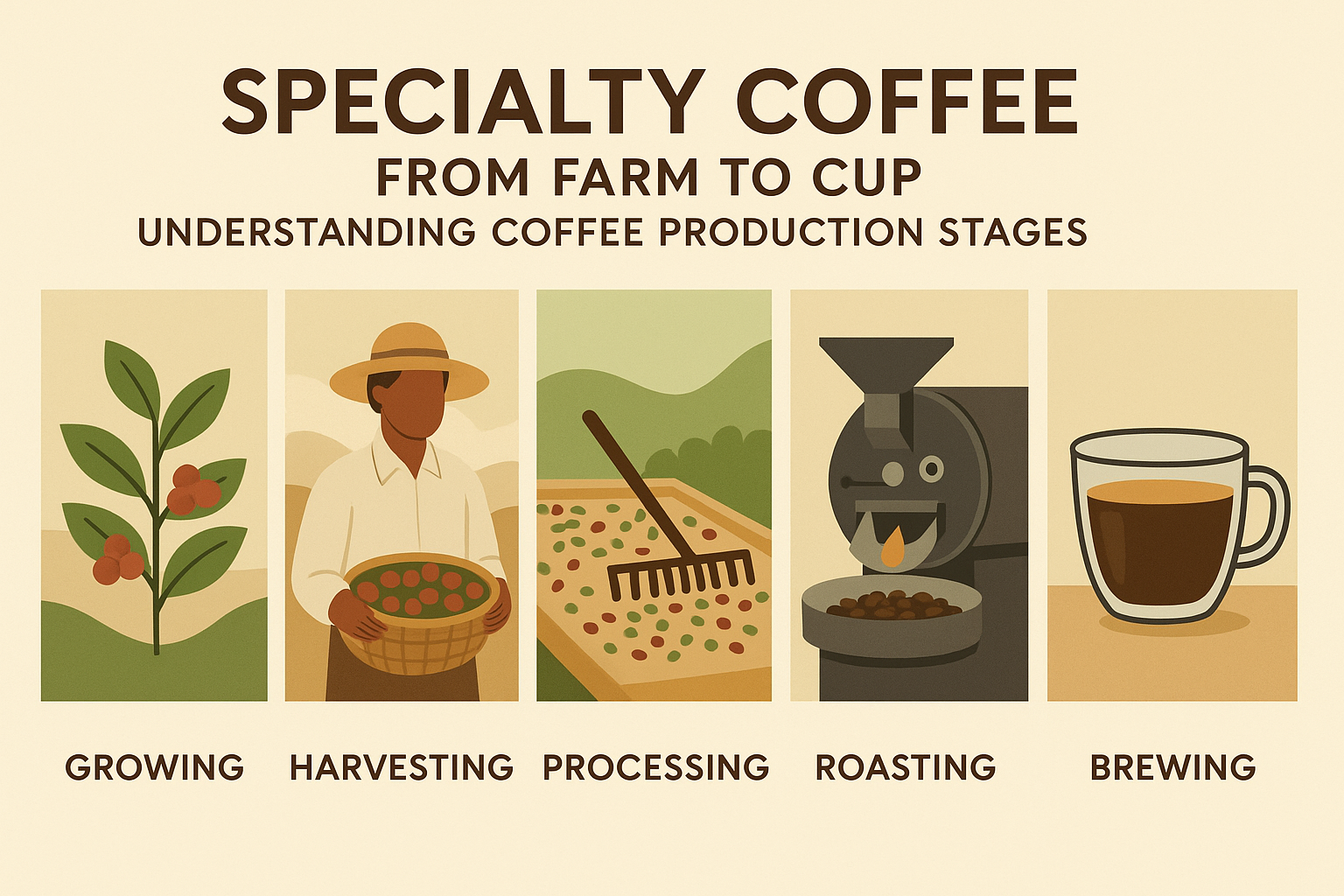Behind every cup of specialty coffee is a long journey that begins far away from the café.
As a barista, understanding the stages of coffee production helps you appreciate the craft, value the work of producers, and explain the origin of the coffee you serve.
From the moment a seed is planted to the final brew in a customer’s cup, coffee goes through multiple hands, processes, and environments. This journey impacts flavor, quality, sustainability, and ultimately, the experience in the cup.
Let’s explore each stage of the coffee production chain and why it matters to every aspiring barista.
1. Cultivation: Growing the Coffee Plant
Every great coffee starts with a healthy plant. Coffee trees take several years to mature and begin producing cherries. There are two main species cultivated commercially: Arabica and Robusta.
Arabica requires high altitudes, cooler climates, and rich soil. It’s more delicate but produces higher quality beans. Robusta grows at lower elevations, tolerates heat, and has higher resistance to pests and diseases.
Farmers must consider rainfall, temperature, elevation, and soil health to produce consistent, specialty-grade coffee. The altitude and climate also contribute directly to flavor. Higher elevations often lead to slower bean maturation, resulting in more complex flavors.
2. Harvesting: Picking the Coffee Cherries
Once the coffee cherries ripen — turning red or yellow, depending on the variety — it’s time to harvest. This step is critical, as only ripe cherries produce the best flavor.
There are two main harvesting methods:
- Selective Picking: Only the ripest cherries are hand-picked. This is labor-intensive but ensures higher quality. It’s the preferred method in specialty coffee.
- Strip Picking: All cherries are removed from the branch at once, regardless of ripeness. This is faster but results in mixed-quality beans.
Hand-picking allows farmers to separate under- or overripe cherries, which can negatively impact flavor and balance in the cup.
3. Processing: Removing the Fruit from the Bean
After harvesting, the coffee cherries need to be processed quickly to prevent fermentation. Processing is one of the most influential stages for flavor development.
The three most common processing methods are:
- Washed (Wet) Process: Cherries are pulped to remove skin and mucilage, then fermented in water. This creates clean, bright, and acidic coffees.
- Natural (Dry) Process: Cherries are dried whole, allowing the fruit to ferment around the bean. This creates sweet, fruity, and heavier-bodied coffees.
- Honey (Semi-Washed): Some of the mucilage is left on during drying. This creates a balance between the washed and natural methods — sweet, smooth, and complex.
Each method affects sweetness, acidity, and mouthfeel. As a barista, knowing how your coffee was processed helps you choose the best brew method to highlight its strengths.
4. Drying: Reducing Moisture for Stability
Once the beans are processed, they must be dried to a specific moisture level — usually between 10% and 12%. Too much moisture can cause mold; too little can result in a flat or lifeless taste.
Drying can take place:
- On raised beds: Provides airflow and even drying.
- On patios: Cherries or beans are spread out and turned regularly.
- In mechanical dryers: Used when the climate doesn’t support natural drying.
Proper drying is crucial for preserving quality. Poor drying leads to inconsistent roasting and unpleasant flavors in the cup.
5. Milling: Preparing Beans for Export
Before the beans can be roasted, they must be milled. This involves:
- Hulling: Removing any remaining parchment (in washed coffees) or dried fruit (in natural coffees).
- Polishing (optional): Improves appearance by removing silver skin.
- Grading and Sorting: Beans are graded by size, weight, and density. Defects are removed to ensure only the best beans move forward.
Milling ensures uniformity — a key component of even roasting and flavor consistency.
6. Exporting: Transporting the Green Coffee
Once milled, the green coffee beans are bagged and shipped to roasters around the world. Specialty beans are often packaged in jute or GrainPro bags to protect freshness.
During this stage, quality can still be affected by poor storage, humidity, pests, or contamination. Exporters, importers, and logistics teams must ensure the coffee is transported in clean, dry, and well-ventilated conditions.
Roasters who work directly with farms (direct trade) often monitor these logistics closely to maintain quality and transparency.
7. Roasting: Transforming Green Beans into Flavor
Roasting is the moment when coffee’s potential becomes real. It’s a combination of science and artistry, transforming dense green beans into aromatic, flavorful roasted coffee.
Roasters apply precise heat curves to control development. Key stages in roasting include:
- Drying Phase: Removes remaining moisture.
- Maillard Reaction: Begins browning and flavor development.
- First Crack: Signals the start of full development.
- Development Phase: Fine-tunes acidity, sweetness, and body.
Light roasts preserve acidity and highlight origin flavors. Medium roasts balance brightness and body. Dark roasts emphasize bitterness and boldness.
As a barista, understanding roast profiles helps you choose the right brew method, dial in espresso, and explain flavors to customers.
8. Degassing and Packaging: Preserving Freshness
After roasting, beans release carbon dioxide for several hours or days. This process is called degassing. Brewing too soon can lead to uneven extraction. Waiting 3–5 days is ideal.
Beans should then be packed in valve-sealed, air-tight bags that protect against oxygen, moisture, and light. Quality packaging is a sign of care and professionalism.
Always check the roast date. Specialty coffee is best consumed within 2 to 4 weeks after roasting for optimal flavor.
9. Grinding: Matching the Grind to the Brew Method
Grinding happens just before brewing and has a huge impact on taste. The size of the grind affects how water extracts the coffee’s soluble compounds.
Common grind sizes include:
- Coarse: For French press and cold brew.
- Medium: For drip and pour-over.
- Fine: For espresso.
- Extra fine: For Turkish coffee.
As a barista, you’ll adjust grind size daily depending on humidity, temperature, and equipment. This is one of your most important tasks.
Freshly ground coffee always tastes better. If possible, grind to order to preserve aroma and complexity.
10. Brewing: The Final Transformation
Now comes the part you see every day: brewing. But this step depends on everything that came before. You’re not just making coffee — you’re completing a process that began months or years earlier.
Brewing variables include:
- Water temperature
- Ratio of coffee to water
- Brew time
- Grind size
- Brew method
Every detail matters. Whether you’re using a V60, AeroPress, French press, or espresso machine, your technique must match the bean’s characteristics.
In specialty coffee, brewing is not about repetition — it’s about intentionality. Your job is to bring out the best of what’s already in the bean.
11. Serving: Delivering an Experience
Serving coffee is the final stage. It’s your chance to connect with the customer and share the story behind the cup.
You can talk about the origin, the flavor notes, or even the farmer’s name. These personal details enhance the customer’s appreciation and set your service apart.
Presentation matters too — from latte art to clean cups to a friendly smile. Every detail contributes to the overall impression of quality.
Why This Knowledge Matters for Baristas
Understanding the journey from farm to cup changes the way you brew and serve coffee. You become more than someone who presses buttons — you become a professional who respects the product.
It also helps you troubleshoot. If a coffee tastes off, you can ask better questions: Was it over-fermented? Was the roast too dark? Is the grind too fine?
This insight builds confidence and earns the trust of your team and your customers.
Final Thoughts: Respect the Journey
Every step in the coffee production chain adds value. The farmers, processors, exporters, roasters, and baristas are all part of a global ecosystem working toward one goal: a delicious cup.
When you understand this chain, you don’t just make coffee — you honor it.
So next time you brew, remember that the beans in your portafilter or pour-over didn’t get there by accident. They’ve traveled far. They’ve been cared for. And now, it’s your turn to bring them to life.

Marcelo Rodrigues is a passionate barista with over 7 years of experience in specialty coffee. He’s worked in top cafés, led barista training sessions, and now shares practical tips to help beginners and coffee lovers improve their skills. Through this blog, Marcel makes the world of coffee more accessible—one cup at a time.

